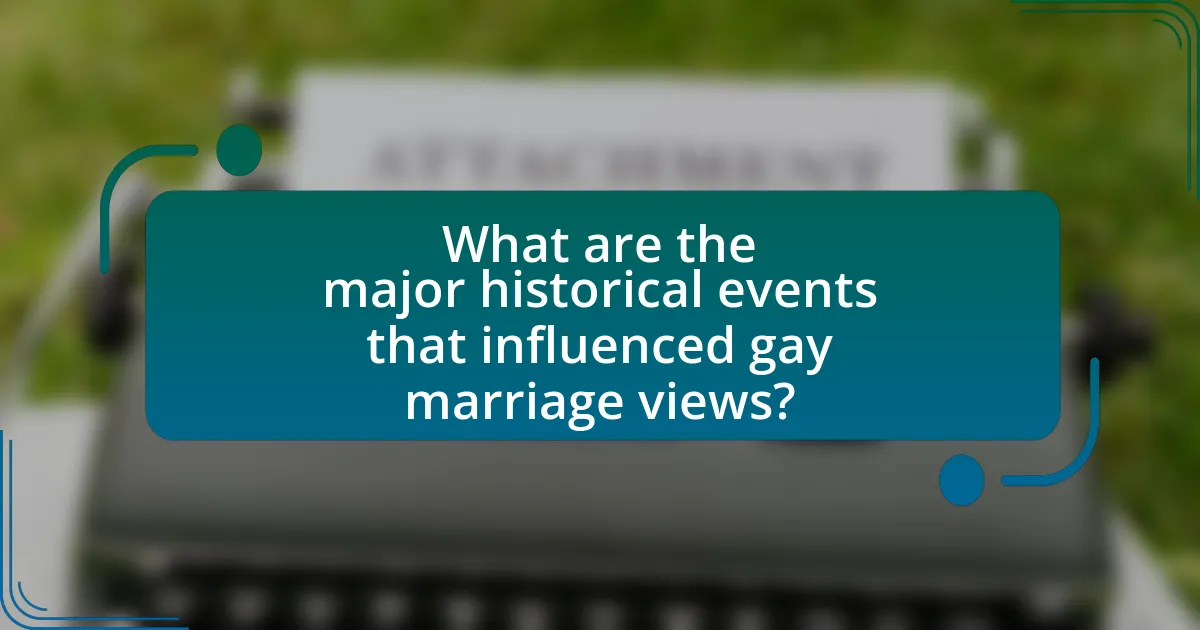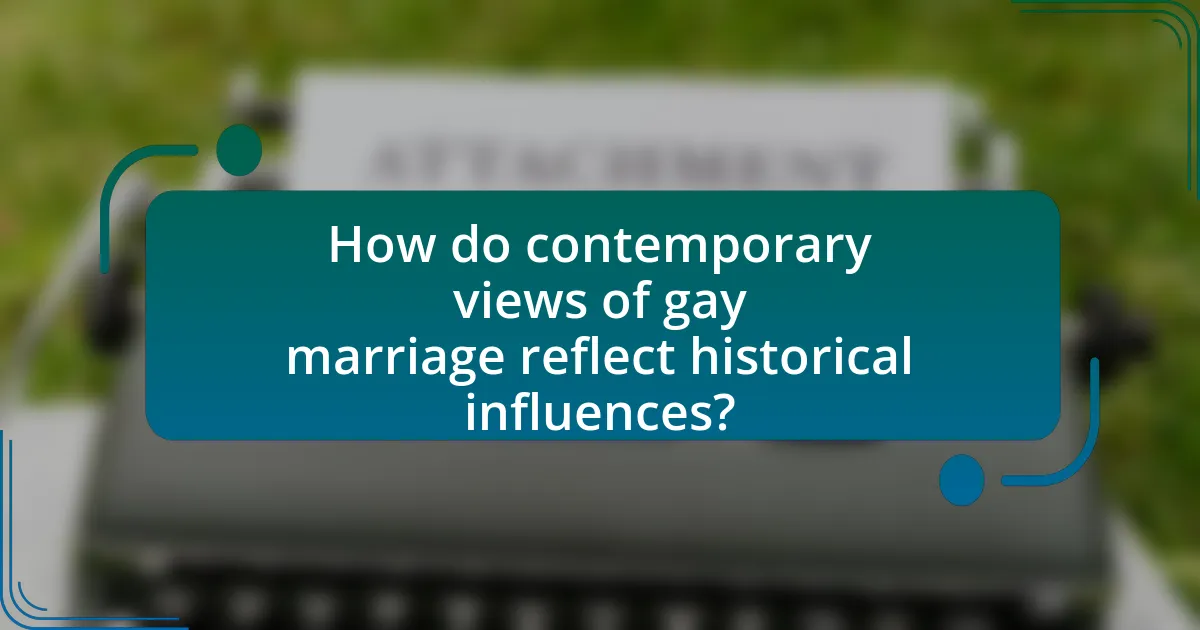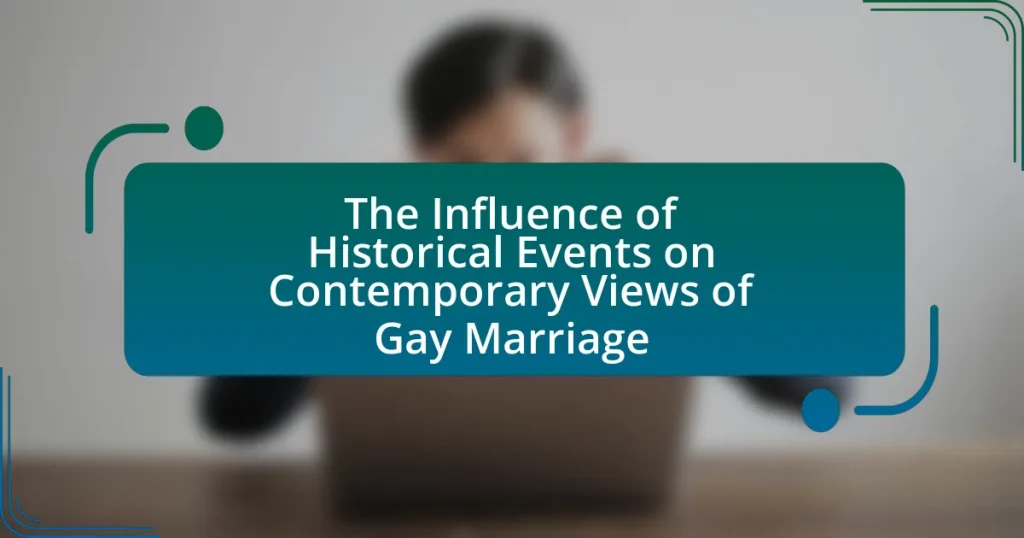The article examines the influence of historical events on contemporary views of gay marriage, highlighting key milestones such as the Stonewall Riots of 1969 and the U.S. Supreme Court’s decision in Obergefell v. Hodges in 2015. It discusses how these events have shaped societal attitudes and legal frameworks, illustrating the evolution of public perception regarding LGBTQ+ rights. The article also explores the role of social movements, landmark legal cases, and the impact of cultural and religious factors on the acceptance of gay marriage, emphasizing the importance of understanding historical context in current advocacy efforts.

What is the Influence of Historical Events on Contemporary Views of Gay Marriage?
Historical events significantly shape contemporary views of gay marriage by influencing societal norms and legal frameworks. For instance, the Stonewall Riots of 1969 marked a pivotal moment in the LGBTQ+ rights movement, leading to increased visibility and activism that ultimately contributed to changing public perceptions. Additionally, the legalization of same-sex marriage in various countries, such as the U.S. Supreme Court’s decision in Obergefell v. Hodges in 2015, reinforced the acceptance of gay marriage and reflected evolving societal attitudes. These historical milestones serve as benchmarks that inform current discussions and beliefs about marriage equality, demonstrating how past struggles and victories continue to resonate in contemporary discourse.
How have historical events shaped societal attitudes towards gay marriage?
Historical events have significantly shaped societal attitudes towards gay marriage by influencing public perception and legal recognition. The Stonewall Riots of 1969 marked a pivotal moment in LGBTQ+ activism, leading to increased visibility and advocacy for gay rights. This event catalyzed the modern LGBTQ+ rights movement, fostering a shift in societal attitudes as more individuals began to support equality and acceptance.
Subsequent milestones, such as the decriminalization of homosexuality in various countries and the legalization of same-sex marriage in places like the Netherlands in 2001, further contributed to changing perceptions. Public opinion polls in the United States, for instance, showed a dramatic increase in support for gay marriage from 27% in 1996 to over 60% by 2021, reflecting the impact of these historical events on societal views.
Additionally, landmark court cases, such as Obergefell v. Hodges in 2015, which legalized same-sex marriage nationwide in the U.S., reinforced the notion of marriage equality as a civil right, further solidifying societal acceptance. These historical events collectively illustrate how activism, legal changes, and cultural shifts have transformed attitudes towards gay marriage over time.
What key historical milestones have impacted the perception of gay marriage?
Key historical milestones that have impacted the perception of gay marriage include the decriminalization of homosexuality in various countries, the Stonewall Riots of 1969, and the legalization of same-sex marriage in numerous jurisdictions. The decriminalization of homosexuality, beginning in the late 20th century, shifted societal views towards acceptance, as seen in the U.S. Supreme Court’s 2003 ruling in Lawrence v. Texas, which invalidated sodomy laws. The Stonewall Riots marked a pivotal moment in the LGBTQ+ rights movement, galvanizing activism and increasing visibility for gay rights. Furthermore, the legalization of same-sex marriage in countries like the Netherlands in 2001 and the U.S. Supreme Court’s 2015 decision in Obergefell v. Hodges, which recognized same-sex marriage as a constitutional right, significantly altered public perception, leading to broader acceptance and normalization of gay marriage in society.
How did the civil rights movement influence views on gay marriage?
The civil rights movement significantly influenced views on gay marriage by framing the struggle for LGBTQ+ rights as a continuation of the fight against discrimination and inequality. Activists drew parallels between racial discrimination and the marginalization of sexual minorities, emphasizing that both groups sought equal rights and recognition under the law. This connection was highlighted during the 1960s and 1970s, when prominent civil rights leaders, such as Bayard Rustin, openly supported LGBTQ+ rights, thereby legitimizing the movement within the broader context of social justice. The legal victories achieved by the civil rights movement, such as the Civil Rights Act of 1964, provided a framework for LGBTQ+ activists to advocate for marriage equality, culminating in landmark rulings like Obergefell v. Hodges in 2015, which legalized same-sex marriage nationwide.
Why is understanding historical context important for contemporary discussions on gay marriage?
Understanding historical context is crucial for contemporary discussions on gay marriage because it provides insight into the evolution of societal attitudes and legal frameworks surrounding LGBTQ+ rights. Historical events, such as the Stonewall Riots in 1969, marked a significant turning point in the fight for gay rights, highlighting the struggles and resilience of the LGBTQ+ community. Additionally, the legalization of same-sex marriage in various countries, including the landmark U.S. Supreme Court decision in Obergefell v. Hodges in 2015, reflects shifts in public opinion and legal recognition over time. By examining these historical milestones, contemporary discussions can better appreciate the ongoing challenges and progress in achieving equality, ensuring that the dialogue is informed by the lessons learned from past struggles.
What role does historical context play in shaping current legal frameworks for gay marriage?
Historical context plays a crucial role in shaping current legal frameworks for gay marriage by influencing societal attitudes and legislative actions. The evolution of public perception regarding LGBTQ+ rights, particularly since the Stonewall Riots in 1969, has led to significant legal advancements, such as the U.S. Supreme Court’s decision in Obergefell v. Hodges in 2015, which legalized same-sex marriage nationwide. This decision was rooted in a historical trajectory that included the decriminalization of homosexuality, the AIDS crisis, and the advocacy efforts of various civil rights movements, all of which contributed to a shift in public opinion and legal recognition of same-sex relationships. Thus, the historical context not only informs the legal landscape but also reflects the ongoing struggle for equality and acceptance within society.
How do historical narratives affect public opinion on gay marriage today?
Historical narratives significantly shape public opinion on gay marriage today by framing the discourse around LGBTQ+ rights and acceptance. For instance, the historical context of the Stonewall Riots in 1969 serves as a pivotal moment that galvanized the LGBTQ+ rights movement, influencing contemporary views by highlighting the struggle for equality and justice. Research indicates that awareness of such historical events correlates with increased support for gay marriage; a 2019 study published in the Journal of Social Issues found that individuals who are educated about LGBTQ+ history are more likely to support marriage equality. This connection illustrates how historical narratives not only inform public understanding but also foster empathy and acceptance, ultimately impacting legislative outcomes and societal attitudes toward gay marriage.

What are the major historical events that influenced gay marriage views?
Major historical events that influenced views on gay marriage include the Stonewall Riots of 1969, which marked a significant turning point in the LGBTQ+ rights movement, leading to increased visibility and activism. The AIDS crisis in the 1980s further galvanized the community and highlighted the need for legal recognition and rights, including marriage. The Massachusetts Supreme Judicial Court’s decision in 2003 to legalize same-sex marriage was a landmark moment, setting a precedent for other states. Additionally, the U.S. Supreme Court’s ruling in Obergefell v. Hodges in 2015, which legalized same-sex marriage nationwide, solidified the shift in public opinion and legal recognition of gay marriage. These events collectively shaped societal attitudes and legal frameworks surrounding gay marriage.
Which landmark legal cases have changed the landscape of gay marriage?
The landmark legal cases that have changed the landscape of gay marriage include Obergefell v. Hodges, United States v. Windsor, and Lawrence v. Texas. Obergefell v. Hodges, decided by the U.S. Supreme Court in 2015, established the constitutional right to same-sex marriage, affirming that states cannot deny marriage licenses to same-sex couples. United States v. Windsor, decided in 2013, struck down key provisions of the Defense of Marriage Act (DOMA), which had defined marriage as between one man and one woman, thereby allowing federal recognition of same-sex marriages. Lawrence v. Texas, decided in 2003, decriminalized same-sex sexual conduct, which laid the groundwork for later marriage equality cases by affirming the rights of LGBTQ+ individuals. These cases collectively shifted legal and societal perceptions of gay marriage, leading to broader acceptance and legal recognition.
What was the significance of the Obergefell v. Hodges decision?
The Obergefell v. Hodges decision was significant because it legalized same-sex marriage nationwide in the United States, affirming that the right to marry is a fundamental liberty protected by the Constitution. This landmark ruling, issued by the Supreme Court on June 26, 2015, established that state bans on same-sex marriage and refusal to recognize legal marriages performed in other jurisdictions violated the Equal Protection and Due Process Clauses of the Fourteenth Amendment. The decision marked a pivotal moment in the LGBTQ+ rights movement, reflecting a significant shift in societal attitudes toward gay marriage and influencing contemporary views on marriage equality across the nation.
How did earlier cases like Lawrence v. Texas contribute to the acceptance of gay marriage?
Earlier cases like Lawrence v. Texas significantly contributed to the acceptance of gay marriage by establishing legal precedents that affirmed the rights of LGBTQ+ individuals. The 2003 Supreme Court decision in Lawrence v. Texas invalidated sodomy laws, thereby decriminalizing same-sex sexual activity and reinforcing the notion that private consensual conduct is protected under the right to privacy. This ruling laid the groundwork for subsequent cases by framing LGBTQ+ rights as fundamental human rights deserving of legal protection. The legal reasoning in Lawrence emphasized dignity and autonomy, which influenced later decisions, including Obergefell v. Hodges in 2015, where the Supreme Court recognized the constitutional right to marry for same-sex couples. Thus, Lawrence v. Texas played a crucial role in shifting public perception and legal standards towards greater acceptance of gay marriage.
How have social movements contributed to the evolution of gay marriage views?
Social movements have significantly shaped the evolution of gay marriage views by advocating for LGBTQ+ rights and visibility. The Stonewall Riots in 1969 marked a pivotal moment, galvanizing activism and leading to the formation of organizations like the Human Rights Campaign, which lobbied for legal recognition of same-sex relationships. Over the decades, these movements have utilized public demonstrations, legal challenges, and media campaigns to shift societal perceptions, culminating in the landmark Supreme Court decision in 2015 that legalized gay marriage nationwide. This decision reflected a broader acceptance of LGBTQ+ individuals, driven by the persistent efforts of social movements to challenge discrimination and promote equality.
What impact did the Stonewall Riots have on the gay rights movement?
The Stonewall Riots significantly galvanized the gay rights movement, marking a pivotal turning point in the struggle for LGBTQ+ rights. Occurring in June 1969, the riots were a response to police raids at the Stonewall Inn in New York City, which catalyzed widespread activism and visibility for the LGBTQ+ community. Following the riots, organizations such as the Gay Liberation Front were formed, leading to increased advocacy for equal rights, visibility, and the eventual establishment of Pride marches. The events at Stonewall are often credited with inspiring a new era of activism that laid the groundwork for subsequent legal advancements, including the decriminalization of homosexuality and the push for marriage equality, culminating in the landmark Supreme Court decision of Obergefell v. Hodges in 2015.
How have LGBTQ+ advocacy groups influenced public perception of gay marriage?
LGBTQ+ advocacy groups have significantly influenced public perception of gay marriage by promoting awareness, education, and visibility of LGBTQ+ issues. Through campaigns, legal challenges, and public outreach, these organizations have shifted societal attitudes, leading to increased acceptance of same-sex marriage. For instance, the Human Rights Campaign’s efforts in the 2000s, including the “Marriage Equality” campaign, helped to frame gay marriage as a civil rights issue, which resonated with broader social justice movements. As a result, public support for gay marriage rose from approximately 27% in 1996 to over 70% by 2021, according to Gallup polling data. This transformation in public opinion has been crucial in influencing legislative changes and court rulings, culminating in the landmark Supreme Court decision in Obergefell v. Hodges in 2015, which legalized same-sex marriage nationwide.

How do contemporary views of gay marriage reflect historical influences?
Contemporary views of gay marriage reflect historical influences through the evolution of societal norms and legal frameworks surrounding LGBTQ+ rights. The Stonewall Riots of 1969 marked a pivotal moment in the fight for gay rights, leading to increased visibility and activism that shaped public perception. Subsequent legal milestones, such as the decriminalization of homosexuality in various countries and the legalization of same-sex marriage in places like Massachusetts in 2004, further influenced contemporary acceptance. Polls indicate that support for gay marriage has risen significantly over the past few decades, with a 2021 Gallup poll showing that 70% of Americans favor legal recognition of same-sex marriages, illustrating how historical struggles have transformed societal attitudes.
What are the current societal attitudes towards gay marriage in different cultures?
Current societal attitudes towards gay marriage vary significantly across different cultures. In many Western countries, such as the United States and Canada, acceptance of gay marriage is high, with legal recognition established in 2015 and 2005, respectively. Surveys indicate that approximately 70% of Americans support same-sex marriage, reflecting a shift in public opinion influenced by advocacy and historical events like the Stonewall Riots.
Conversely, in many parts of Africa and the Middle East, societal attitudes remain largely negative, with countries like Uganda and Saudi Arabia enforcing strict laws against homosexuality. In these regions, cultural and religious beliefs heavily influence opposition to gay marriage, often resulting in criminalization and social stigma.
In contrast, some Latin American countries, such as Argentina and Uruguay, have embraced gay marriage, with Argentina being the first in the region to legalize it in 2010. Public support in these nations has grown, driven by progressive movements and changing perceptions of LGBTQ+ rights.
Overall, societal attitudes towards gay marriage are shaped by a complex interplay of cultural, religious, and historical factors, leading to a diverse global landscape regarding acceptance and legal recognition.
How do historical events shape cultural differences in views on gay marriage?
Historical events significantly shape cultural differences in views on gay marriage by influencing societal norms, legal frameworks, and public perceptions. For instance, the Stonewall Riots of 1969 marked a pivotal moment in LGBTQ+ activism in the United States, leading to increased visibility and advocacy for gay rights, which in turn fostered more progressive views on marriage equality. In contrast, countries with histories of colonialism and anti-LGBTQ+ laws, such as many African nations, often maintain conservative views on gay marriage due to the legacy of these oppressive legal systems. Additionally, the legalization of same-sex marriage in various countries, such as the Netherlands in 2001, has created a ripple effect, encouraging other nations to reconsider their stances based on changing global norms. These historical contexts illustrate how past events directly influence contemporary cultural attitudes towards gay marriage.
What role does religion play in contemporary views of gay marriage?
Religion significantly influences contemporary views of gay marriage, often shaping opinions based on doctrinal beliefs and cultural traditions. Many religious groups, particularly conservative denominations, oppose gay marriage, citing scriptural interpretations that define marriage as a union between a man and a woman. For instance, the Catholic Church and many evangelical Protestant groups maintain that same-sex relationships contradict their teachings on sexuality and family structure. Conversely, more progressive religious communities, such as certain branches of Judaism and the United Church of Christ, support gay marriage, advocating for inclusivity and equality based on principles of love and justice. This division reflects broader societal debates, where religious beliefs intersect with evolving cultural norms regarding LGBTQ+ rights, illustrating the complex role religion plays in shaping public attitudes toward gay marriage.
How can understanding historical influences help in advocating for gay marriage today?
Understanding historical influences is crucial in advocating for gay marriage today because it provides context for the struggles and progress of LGBTQ+ rights. Historical events, such as the Stonewall Riots in 1969, marked a significant turning point in the fight for gay rights, highlighting the community’s resilience and the need for legal recognition. By examining these events, advocates can draw parallels to current challenges, demonstrating that the fight for equality has deep roots and is part of a larger narrative of civil rights. This historical perspective can mobilize support by illustrating the ongoing discrimination faced by LGBTQ+ individuals and the importance of legal protections, thereby reinforcing the argument for marriage equality as a fundamental human right.
What strategies can be employed to leverage historical context in current advocacy efforts?
To leverage historical context in current advocacy efforts for gay marriage, advocates can employ strategies such as utilizing historical narratives, drawing parallels between past civil rights movements, and highlighting significant legal milestones. Historical narratives, such as the Stonewall Riots of 1969, can be used to frame contemporary struggles for equality, emphasizing the ongoing fight against discrimination. By drawing parallels to other civil rights movements, such as the African American civil rights movement, advocates can illustrate the universal quest for justice and equality, thereby fostering solidarity. Additionally, highlighting legal milestones, such as the Supreme Court’s decision in Obergefell v. Hodges in 2015, can serve as a reminder of progress made and the importance of continued advocacy to protect those rights. These strategies effectively connect historical context to current advocacy efforts, reinforcing the message that the fight for gay marriage is part of a broader historical struggle for human rights.
How can lessons from history inform future policies regarding gay marriage?
Lessons from history can inform future policies regarding gay marriage by highlighting the evolution of civil rights and the impact of social movements on legal recognition. Historical milestones, such as the Stonewall Riots in 1969, demonstrate how activism can lead to significant legal changes, ultimately culminating in the U.S. Supreme Court’s decision in Obergefell v. Hodges (2015), which legalized same-sex marriage nationwide. This trajectory illustrates that policies can be shaped by societal shifts and the recognition of equality, emphasizing the importance of inclusive legislation that reflects changing public attitudes. Additionally, examining past resistance to LGBTQ+ rights can guide policymakers in addressing ongoing discrimination and ensuring protections against future setbacks.
What practical steps can individuals take to promote understanding of gay marriage in light of historical influences?
Individuals can promote understanding of gay marriage by educating themselves and others about its historical context, including key events such as the Stonewall Riots of 1969, which marked a significant turning point in the LGBTQ+ rights movement. By sharing factual information about these historical influences, individuals can help dispel myths and misconceptions surrounding gay marriage. For instance, discussing the legal milestones, such as the U.S. Supreme Court’s decision in Obergefell v. Hodges in 2015, which legalized same-sex marriage nationwide, can illustrate the progress made and the ongoing challenges faced by the LGBTQ+ community. Engaging in open dialogues, attending workshops, and participating in community events focused on LGBTQ+ history can further enhance understanding and foster empathy.


